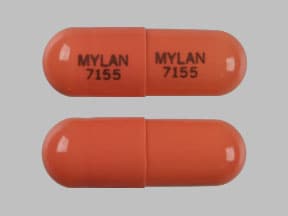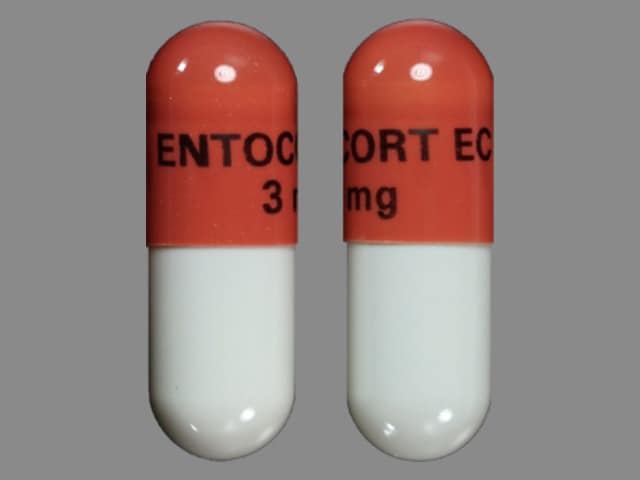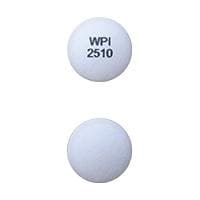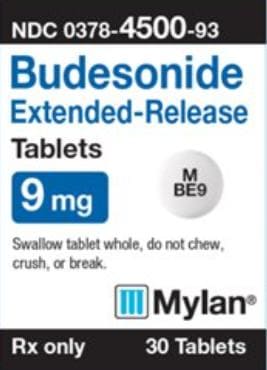Dosage Forms
Excipient information presented when available (limited, particularly for generics); consult specific product labeling.
Capsule Delayed Release Particles, Oral:
Entocort EC: 3 mg
Generic: 3 mg
Tablet Extended Release 24 Hour, Oral:
Uceris: 9 mg [contains soybean lecithin]
Generic: 9 mg
Pharmacology
Mechanism of Action
Budesonide, a glucocorticoid with high topical potency and limited systemic effects, depresses the activity of endogenous chemical mediators of inflammation (eg, kinins, prostaglandins). Oral budesonide formulations allow for targeted, pH-dependent budesonide release in the treatment of IBD (eg, Crohn disease, ulcerative colitis). The controlled release capsule contains enteric coated granules that dissolve at a pH ≥5.5, delivering budesonide to the ileum and ascending colon. The multimatrix enteric coated tablet dissolves at a pH ≥7, delivering budesonide to the entire colon (Abdalla 2016; Iborra 2014).
Pharmacokinetics/Pharmacodynamics
Distribution
Children ≥9 years and Adolescents ≤14 years: IV: 2.2 ± 0.4 L/kg
Adults: 2.2 to 3.9 L/kg
Metabolism
Hepatic via CYP3A4 to two metabolites: 16 alpha-hydroxyprednisolone and 6 beta-hydroxybudesonide; both are <1% as active as parent
Excretion
Urine (60%) and feces as metabolites
Time to Peak
Capsule: Children ≥9 years and Adolescents ≤14 years: Median: 5 hours; Adults: 0.5 to 10 hours; Tablet (extended release): 13.3 ± 5.9 hours
Half-Life Elimination
IV:
Children ≥9 years and Adolescents ≤14 years: 1.9 hours
Adults: 2 to 3.6 hours
Protein Binding
85% to 90%
Use in Specific Populations
Special Populations: Hepatic Function Impairment
Increased systemic exposure (≥2.5 fold) has been reported in moderate hepatic impairment.
Use: Labeled Indications
Crohn disease, mild to moderate (capsules): Treatment of active Crohn disease (mild to moderate) involving the ileum and/or the ascending colon in patients ≥8 years of age; maintenance of clinical remission (for up to 3 months) of Crohn disease (mild to moderate) involving the ileum and/or the ascending colon in adults
Ulcerative colitis (tablets): Induction of remission in patients with active ulcerative colitis (mild to moderate)
Use: Off Label
Eosinophilic esophagitisbyes
Data from controlled trials and meta-analyses indicate that inhalational budesonide, when swallowed rather than inhaled, is effective at improving the clinicopathologic features of eosinophilic esophagitis. Guidelines from the American College of Gastroenterology (ACG) and consensus recommendations from the American Gastroenterological Association (AGA)/North American Society of Pediatric Gastroenterology, Hepatology, and Nutrition (NASPGHAN) regarding diagnosis and management of eosinophilic esophagitis recommend that oral administration of inhalational corticosteroids (eg, fluticasone, budesonide) be considered as first-line therapy for eosinophilic esophagitis and that the corticosteroid type and duration of therapy be individualized. Symptoms often recur upon discontinuation, and steroid resistance has been reported.
Microscopic (lymphocytic and collagenous) colitisbyes
Data from multiple small randomized, double-blind, placebo-controlled trials support the use of budesonide as an effective treatment for induction of clinical remission and histological improvement in patients with active lymphocytic colitis Miehlke 2009, Miehlke 2018. Data from multiple small, randomized, double-blind, placebo-controlled trials support the use of budesonide as an effective treatment for the induction and maintenance of clinical remission, histological improvement, and quality of life improvement in patients with active collagenous colitis Bonderup 2009, Madisch 2005, Miehlke 2002, Miehlke 2008, Miehlke 2014.
Based on the American Gastroenterological Association Institute Guideline on the Medical Management of Microscopic Colitis, budesonide is recommended as first line therapy for the induction and maintenance of clinical remission in patients with symptomatic microscopic colitis.
Contraindications
Hypersensitivity to budesonide or any component of the formulation
Documentation of allergenic cross-reactivity for corticosteroids is limited. However, because of similarities in chemical structure and/or pharmacologic actions, the possibility of cross-sensitivity cannot be ruled out with certainty.
Canadian labeling: Additional contraindications (not in US labeling): Active tuberculosis; systemic or local bacterial, fungal or viral infections; hypersensitivity to soya, lecithin (derived from soya oil, peanut oil), or peanut (Cortiment)
Dosage and Administration
Dosing: Adult
Crohn disease, mild to moderate (active): Oral: Capsule: 9 mg once daily in the morning for up to 8 weeks; recurring episodes may be treated with a repeat 8-week course of treatment.
Maintenance of remission: Following treatment of active disease (control of symptoms with Crohn Disease Activity Index [CDAI] <150), treatment may be continued at a dosage of 6 mg once daily for up to 3 months. If symptom control is maintained for 3 months, tapering of the dosage to complete cessation is recommended. Continued dosing beyond 3 months has not been demonstrated to result in substantial benefit.
Eosinophilic esophagitis (off-label use): Oral: 2 mg/day as an oral budesonide viscous liquid/suspension. Dose may be divided into 2 doses. Avoid ingesting any solid or liquid food for 30 minutes after budesonide administration (Dellon 2013; Dohil 2010; Liacouras 2011; Rubinstein 2014).
Microscopic (lymphocytic and collagenous) colitis (off-label use): Oral:
Induction: 9 mg once daily for 6 to 8 weeks (AGA [Nguyen 2016]; Miehlke 2002; Miehlke 2018). After clinical remission (<3 stools daily and no watery stools) and following at least 8 weeks of therapy, some experts suggest to gradually taper the dose to 6 mg for 2 weeks, followed by 3 mg for 2 weeks, then discontinue (Dietrich 2019).
Maintenance/relapse therapy: Note: For patients who have had a clinical relapse after cessation of induction therapy (AGA [Nguyen 2016]). 6 mg once daily, then taper to the lowest effective dose and continue for 6 to 12 months (AGA [Nguyen 2016]; Bonderup 2009; Miehlke 2008); alternatively, 3 mg/day alternating with 6 mg/day over 12 months may be used (AGA [Nguyen 2016]).
Ulcerative colitis (active): Oral: Tablet: 9 mg once daily in the morning for up to 8 weeks
Dosing: Geriatric
Refer to adult dosing.
Dosing: Pediatric
Crohn disease (mild to moderate); treatment:
Manufacturer's labeling: Children ≥8 years and Adolescents weighing >25 kg: Oral: Capsule (Entocort EC): 9 mg once daily for up to 8 weeks then 6 mg once daily for 2 weeks
Alternate dosing: Limited data available: Children ≥6 years and Adolescents: Oral: Capsule (Entocort EC): Induction: 9 mg once daily or in divided doses every 8 hours for 7 to 8 weeks, followed by a maintenance dose of 6 mg daily for 3 to 4 weeks; therapy was discontinued after a total duration of 10 to 12 weeks (Escher 2004; Levine 2003; Levine 2009). In another study of patients 10 to 19 years of age, a trend for higher remission rates using an initial dose of 12 mg daily for 4 weeks, followed by 9 mg daily for 3 weeks, followed by 6 mg daily for 3 weeks was observed (Levine 2009).
Eosinophilic esophagitis: Limited data available: Note: Requires extemporaneous preparation of oral viscous budesonide suspension using the inhalation suspension (see Extemporaneous Preparations). Although there are other dosage forms of oral budesonide, they are enteric coated and should not be used for this indication; therapeutic efficacy for eosinophilic esophagitis requires topical corticosteroid effect in the esophagus. After administration of a budesonide dose, avoid ingesting any solid or liquid food for at least 30 minutes.
Children <10 years: Oral: Viscous liquid/suspension (using inhalation suspension): Initial: 1 mg once daily or divided twice daily. (Aceves 2005; Aceves 2007; Liacouras 2011; Rubinstein 2014)
Children ≥10 years and Adolescents: Oral: Viscous liquid/suspension (using inhalation suspension): 2 mg once daily or divided twice daily (Aceves 2007; Liacouras 2011; Rubinstein 2014)
Protein-losing enteropathy (PLE) following Fontan: Limited data available: Children ≥7 years and Adolescents: Oral capsule (Entocort EC): Initial: 9 mg once daily or in divided doses every 8 hours; after clinical improvement and albumin >3 g/dL may then wean dose over several weeks to 3 mg once daily or every other day; if during the weaning process the serum albumin decreases to <2.5 g/dL, do not further reduce dose, consider dosage increase. Dosing based on several case series describing institutional experiences, the majority of pediatric patients described were ≥7 years of age (n=17) (John 2011; Schumacher 2011; Thacker 2010; Turner 2012). Reported experience in children <7 years is very limited (n=1); in one report, an initial dose of 6 mg once daily was recommended for children <4 years (Thacker 2010).
Extemporaneously Prepared
Oral viscous budesonide liquid/suspension: An oral viscous budesonide suspension may be made using nebulization suspension (eg, Pulmicort Respules) and Splenda (sucralose) packets. Mix 10 packets of Splenda (10 g sucralose) for every 1 mg of budesonide until slurry is formed. Respules/vials containing budesonide 0.5 mg/2 mL is reported most often and provides a volume of ~8 to 12 mL. Use of 2.5 mL of Neocate Nutra for every 1 mg of budesonide has also been reported. Oral viscous budesonide suspension should be prepared immediately prior to ingestion (Aceves 2007; Dohil 2010; Rubinstein 2014).
Aceves SS, Bastian JF, Newbury RO, Dohil R. Oral viscous budesonide: a potential new therapy for eosinophilic esophagitis in children. Am J Gastroenterol. 2007;102(10):2271-227917581266Dohil R, Newbury R, Fox L, Bastian J, Aceves S. Oral viscous budesonide is effective in children with eosinophilic esophagitis in a randomized, placebo-controlled trial. Gastroenterology. 2010;139(2):418-429.20457157Rubinstein E, Lee JJ, Fried A, et al. Comparison of 2 delivery vehicles for viscous budesonide to treat eosinophilic esophagitis in children. J Pediatr Gastroenterol Nutr. 2014;59(3):317-320.24821535
Administration
Oral:
Capsule: Administer in the morning without regard to meals. Swallow whole; do not crush or chew. Capsule may be opened and granules sprinkled onto 1 tablespoonful of applesauce (applesauce should be soft enough to swallow without chewing and should not be hot); mix granules with applesauce and consume within 30 minutes of mixing; do not save the mixture for later use. Do not chew or crush granules. Follow with 8 oz of cool water.
Tablet: Swallow whole; do not crush, chew, or break. Administer in the morning without regard to meals.
Viscous liquid/suspension: Swallow extemporaneously prepared liquid immediately after preparation; avoid ingesting any solid or liquid food for at least 30 minutes after budesonide administration.
Dietary Considerations
Avoid grapefruit juice.
Storage
Store at 25°C (77°F); excursions permitted to 15°C to 30°C (59°F to 86°F). Protect from light and moisture.
Budesonide (Systemic) Images
Drug Interactions
Aldesleukin: Corticosteroids may diminish the antineoplastic effect of Aldesleukin. Avoid combination
Antacids: May decrease the bioavailability of Corticosteroids (Oral). Management: Consider separating doses by 2 or more hours. Budesonide enteric coated tablets could dissolve prematurely if given with drugs that lower gastric acid, with unknown impact on budesonide therapeutic effects. Consider therapy modification
Baricitinib: Immunosuppressants may enhance the immunosuppressive effect of Baricitinib. Management: Use of baricitinib in combination with potent immunosuppressants such as azathioprine or cyclosporine is not recommended. Concurrent use with antirheumatic doses of methotrexate or nonbiologic disease modifying antirheumatic drugs (DMARDs) is permitted. Consider therapy modification
BCG (Intravesical): Immunosuppressants may diminish the therapeutic effect of BCG (Intravesical). Avoid combination
Bile Acid Sequestrants: May decrease the absorption of Corticosteroids (Oral). Monitor therapy
Cladribine: May enhance the immunosuppressive effect of Immunosuppressants. Avoid combination
Clofazimine: May increase the serum concentration of CYP3A4 Substrates (High risk with Inhibitors). Monitor therapy
Coccidioides immitis Skin Test: Immunosuppressants may diminish the diagnostic effect of Coccidioides immitis Skin Test. Monitor therapy
Conivaptan: May increase the serum concentration of CYP3A4 Substrates (High risk with Inhibitors). Avoid combination
Corticorelin: Corticosteroids may diminish the therapeutic effect of Corticorelin. Specifically, the plasma ACTH response to corticorelin may be blunted by recent or current corticosteroid therapy. Monitor therapy
CYP3A4 Inhibitors (Moderate): May increase the serum concentration of Budesonide (Systemic). Avoid combination
CYP3A4 Inhibitors (Strong): May increase the serum concentration of Budesonide (Systemic). Avoid combination
Deferasirox: Corticosteroids may enhance the adverse/toxic effect of Deferasirox. Specifically, the risk for GI ulceration/irritation or GI bleeding may be increased. Monitor therapy
Denosumab: May enhance the adverse/toxic effect of Immunosuppressants. Specifically, the risk for serious infections may be increased. Monitor therapy
Echinacea: May diminish the therapeutic effect of Immunosuppressants. Consider therapy modification
Erdafitinib: May increase the serum concentration of CYP3A4 Substrates (High risk with Inhibitors). Monitor therapy
Fingolimod: Immunosuppressants may enhance the immunosuppressive effect of Fingolimod. Management: Avoid the concomitant use of fingolimod and other immunosuppressants when possible. If combined, monitor patients closely for additive immunosuppressant effects (eg, infections). Consider therapy modification
Fosaprepitant: May increase the serum concentration of CYP3A4 Substrates (High risk with Inhibitors). Monitor therapy
Fusidic Acid (Systemic): May increase the serum concentration of CYP3A4 Substrates (High risk with Inhibitors). Avoid combination
Grapefruit Juice: May increase the serum concentration of Budesonide (Systemic). Avoid combination
Hyaluronidase: Corticosteroids may diminish the therapeutic effect of Hyaluronidase. Management: Patients receiving corticosteroids (particularly at larger doses) may not experience the desired clinical response to standard doses of hyaluronidase. Larger doses of hyaluronidase may be required. Consider therapy modification
Idelalisib: May increase the serum concentration of CYP3A4 Substrates (High risk with Inhibitors). Avoid combination
Larotrectinib: May increase the serum concentration of CYP3A4 Substrates (High risk with Inhibitors). Monitor therapy
Leflunomide: Immunosuppressants may enhance the adverse/toxic effect of Leflunomide. Specifically, the risk for hematologic toxicity such as pancytopenia, agranulocytosis, and/or thrombocytopenia may be increased. Management: Consider not using a leflunomide loading dose in patients receiving other immunosuppressants. Patients receiving both leflunomide and another immunosuppressant should be monitored for bone marrow suppression at least monthly. Consider therapy modification
Natalizumab: Immunosuppressants may enhance the adverse/toxic effect of Natalizumab. Specifically, the risk of concurrent infection may be increased. Avoid combination
Nivolumab: Immunosuppressants may diminish the therapeutic effect of Nivolumab. Consider therapy modification
Ocrelizumab: May enhance the immunosuppressive effect of Immunosuppressants. Monitor therapy
Palbociclib: May increase the serum concentration of CYP3A4 Substrates (High risk with Inhibitors). Monitor therapy
Pidotimod: Immunosuppressants may diminish the therapeutic effect of Pidotimod. Monitor therapy
Pimecrolimus: May enhance the adverse/toxic effect of Immunosuppressants. Avoid combination
Ritodrine: Corticosteroids may enhance the adverse/toxic effect of Ritodrine. Monitor therapy
Roflumilast: May enhance the immunosuppressive effect of Immunosuppressants. Consider therapy modification
Simeprevir: May increase the serum concentration of CYP3A4 Substrates (High risk with Inhibitors). Monitor therapy
Siponimod: Immunosuppressants may enhance the immunosuppressive effect of Siponimod. Monitor therapy
Sipuleucel-T: Immunosuppressants may diminish the therapeutic effect of Sipuleucel-T. Management: Evaluate patients to see if it is medically appropriate to reduce or discontinue therapy with immunosuppressants prior to initiating sipuleucel-T therapy. Consider therapy modification
Smallpox and Monkeypox Vaccine (Live): Immunosuppressants may diminish the therapeutic effect of Smallpox and Monkeypox Vaccine (Live). Monitor therapy
Stiripentol: May increase the serum concentration of CYP3A4 Substrates (High risk with Inhibitors). Management: Use of stiripentol with CYP3A4 substrates that are considered to have a narrow therapeutic index should be avoided due to the increased risk for adverse effects and toxicity. Any CYP3A4 substrate used with stiripentol requires closer monitoring. Consider therapy modification
Tacrolimus (Topical): May enhance the adverse/toxic effect of Immunosuppressants. Avoid combination
Tertomotide: Immunosuppressants may diminish the therapeutic effect of Tertomotide. Monitor therapy
Tofacitinib: Immunosuppressants may enhance the immunosuppressive effect of Tofacitinib. Management: Concurrent use with antirheumatic doses of methotrexate or nonbiologic disease modifying antirheumatic drugs (DMARDs) is permitted, and this warning seems particularly focused on more potent immunosuppressants. Consider therapy modification
Trastuzumab: May enhance the neutropenic effect of Immunosuppressants. Monitor therapy
Upadacitinib: Immunosuppressants may enhance the immunosuppressive effect of Upadacitinib. Avoid combination
Vaccines (Inactivated): Immunosuppressants may diminish the therapeutic effect of Vaccines (Inactivated). Management: Vaccine efficacy may be reduced. Complete all age-appropriate vaccinations at least 2 weeks prior to starting an immunosuppressant. If vaccinated during immunosuppressant therapy, revaccinate at least 3 months after immunosuppressant discontinuation. Consider therapy modification
Adverse Reactions
>10%:
Central nervous system: Headache (15% to 21%)
Dermatologic: Acne vulgaris (15%)
Endocrine & metabolic: Decreased cortisol (foam 17%; tablets 2% to 4%), bruise (15%), moon face (11%)
Gastrointestinal: Nausea (2% to 11%)
Respiratory: Respiratory tract infection (11%)
1% to 10%:
Cardiovascular: Chest pain (<5%), edema (<5%), facial edema (<5%), flushing (<5%), hypertension (<5%), palpitations (<5%), tachycardia (<5%)
Central nervous system: Dizziness (<5% to 7%), fatigue (3% to 5%), agitation (<5%), amnesia (<5%), confusion (<5%), drowsiness (<5%), insomnia (<5%), malaise (<5%), nervousness (<5%), paresthesia (<5%), sleep disorder (<5%), vertigo (<5%)
Dermatologic: Alopecia (<5%), dermatitis (<5%), dermatological disease (<5%), diaphoresis (<5%), eczema (<5%)
Endocrine & metabolic: Hirsutism (≤5%), hypokalemia (1% to <5%), intermenstrual bleeding (<5%), menstrual disease (<5%), weight gain (<5%), adrenocortical insufficiency (foam 4%; capsules >1%), redistribution of body fat (1%)
Gastrointestinal: Diarrhea (10%), dyspepsia (6%), anal disease (<5%), enteritis (<5%), epigastric pain (<5%), exacerbation of Crohn's disease (<5%), gastrointestinal fistula (<5%), glossitis (<5%), hemorrhoids (<5%), increased appetite (<5%), intestinal obstruction (<5%), oral candidiasis (<5%), upper abdominal pain (3% to 4%), flatulence (3%), abdominal distention (2%), constipation (2%)
Genitourinary: Urinary tract infection (2% to <5%), dysuria (<5%), nocturia (<5%), urinary frequency (<5%), hematuria (≥1%), pyuria (≥1%)
Hematologic & oncologic: C-reactive protein increased (1% to <5%), leukocytosis (1% to <5%), purpura (<5%), abnormal neutrophils (≥1%), anemia (≥1%), increased erythrocyte sedimentation rate (≥1%)
Hepatic: Increased serum alkaline phosphatase (≥1%)
Hypersensitivity: Tongue edema (<5%)
Infection: Viral infection (6%), abscess (<5%)
Neuromuscular & skeletal: Ankle edema (7%), arthralgia (5%), arthritis (≤5%), hyperkinesia (<5%), muscle cramps (<5%), myalgia (<5%), tremor (<5%), weakness (<5%)
Ophthalmic: Eye disease (<5%), visual disturbance (<5%)
Otic: Otic infection (<5%)
Respiratory: Sinusitis (8%), bronchitis (<5%), dyspnea (<5%), flu-like symptoms (<5%), pharyngeal disease (<5%), rhinitis (<5%)
Miscellaneous: Fever (<5%)
<1%, postmarketing, and/or case reports: Allergic dermatitis, anaphylaxis, emotional lability, hyperglycemia, maculopapular rash, pancreatitis, peripheral edema, pruritus, pseudotumor cerebri, rectal bleeding, skin rash
Warnings/Precautions
Concerns related to adverse effects:
- Adrenal suppression: May cause hypercortisolism or suppression of hypothalamic-pituitary-adrenal (HPA) axis, particularly in younger children or in patients receiving high doses for prolonged periods. HPA axis suppression may lead to adrenal crisis. Withdrawal and discontinuation of a corticosteroid should be done slowly and carefully. Particular care is required when patients are transferred from systemic corticosteroids to inhaled products or corticosteroids with lower systemic effect due to possible adrenal insufficiency or withdrawal from steroids, including an increase in allergic symptoms. Adult patients receiving >20 mg per day of prednisone (or equivalent) may be most susceptible. Fatalities have occurred due to adrenal insufficiency in asthmatic patients during and after transfer from systemic corticosteroids to aerosol steroids; aerosol steroids do not provide the systemic steroid needed to treat patients having trauma, surgery, or infections.
- Anaphylactoid reactions: Rare cases of anaphylactoid reactions have been observed in patients receiving corticosteroids.
- Immunosuppression: Prolonged use of corticosteroids may increase the incidence of secondary infection, mask acute infection (including fungal infections), prolong or exacerbate viral infections, or limit response to killed or inactivated vaccines. Exposure to chickenpox or measles should be avoided; corticosteroids should not be used to treat ocular herpes simplex. Corticosteroids should not be used for cerebral malaria, fungal infections, viral hepatitis. Close observation is required in patients with latent tuberculosis and/or TB reactivity; restrict use in active TB (only fulminating or disseminated TB in conjunction with antituberculosis treatment). Amebiasis should be ruled out in any patient with recent travel to tropic climates or unexplained diarrhea prior to initiation of corticosteroids. Use with extreme caution in patients with Strongyloides infections; hyperinfection, dissemination and fatalities have occurred.
- Kaposi sarcoma: Prolonged treatment with corticosteroids has been associated with the development of Kaposi sarcoma (case reports); if noted, discontinuation of therapy should be considered (Goedert 2002).
- Myopathy: Acute myopathy has been reported with high-dose corticosteroids, usually in patients with neuromuscular transmission disorders; may involve ocular and/or respiratory muscles; monitor creatine kinase; recovery may be delayed.
- Psychiatric disturbances: Corticosteroid use may cause psychiatric disturbances, including euphoria, insomnia, mood swings, personality changes, severe depression or psychotic manifestations. Preexisting psychiatric conditions may be exacerbated by corticosteroid use.
Disease-related concerns:
- Cardiovascular disease: Use with caution in patients with HF and/or hypertension; use has been associated with fluid retention, electrolyte disturbances, and hypertension. Use with caution following acute MI; corticosteroids have been associated with myocardial rupture.
- Diabetes: Use corticosteroids with caution in patients with diabetes mellitus; may alter glucose production/regulation leading to hyperglycemia.
- Gastrointestinal disease: Use with caution in patients with GI diseases (diverticulitis, fresh intestinal anastomoses, active or latent peptic ulcer, ulcerative colitis, abscess or other pyogenic infection) due to perforation risk.
- Hepatic impairment: Avoid use in patients with severe hepatic impairment (Child-Pugh class C). Consider reduced dosage in patients with moderate hepatic impairment (Child-Pugh Class B); monitor for hypercortisolism. Long-term use of corticosteroids in patients with hepatic impairment, including cirrhosis, has been associated with fluid retention.
- Myasthenia gravis: Use with caution in patients with myasthenia gravis; exacerbation of symptoms has occurred especially during initial treatment with corticosteroids.
- Ocular disease: Use with caution in patients with cataracts and/or glaucoma; increased intraocular pressure, open-angle glaucoma, and cataracts have occurred with prolonged use. Consider routine eye exams in chronic users.
- Osteoporosis: Use with caution in patients with osteoporosis; high doses and/or long-term use of corticosteroids have been associated with increased bone loss and osteoporotic fractures.
- Renal impairment: Use with caution in patients with renal impairment; fluid retention may occur.
- Seizure disorders: Use corticosteroids with caution in patients with a history of seizure disorder; seizures have been reported with adrenal crisis.
- Thyroid disease: Changes in thyroid status may necessitate dosage adjustments; metabolic clearance of corticosteroids increases in hyperthyroid patients and decreases in hypothyroid ones.
Concurrent therapy issues:
- Drug-drug interactions: Potentially significant interactions may exist, requiring dose or frequency adjustment, additional monitoring, and/or selection of alternative therapy. Consult drug interactions database for more detailed information.
Dosage form specific issues:
- Polysorbate 80: Some dosage forms may contain polysorbate 80 (also known as Tweens). Hypersensitivity reactions, usually a delayed reaction, have been reported following exposure to pharmaceutical products containing polysorbate 80 in certain individuals (Isaksson 2002; Lucente 2000; Shelley 1995). Thrombocytopenia, ascites, pulmonary deterioration, and renal and hepatic failure have been reported in premature neonates after receiving parenteral products containing polysorbate 80 (Alade 1986; CDC 1984). See manufacturer’s labeling.
Monitoring Parameters
Serum glucose, electrolytes; blood pressure, weight and other growth parameters, presence of infection; monitor IOP with therapy >6 weeks; bone mineral density; assess HPA axis suppression (eg, ACTH stimulation test, morning plasma cortisol test, urinary free cortisol test)
Pregnancy
Pregnancy Considerations
Some studies have shown an association between first trimester systemic corticosteroid use and oral clefts (Park-Wyllie 2000; Pradat 2003). Systemic corticosteroids may also influence fetal growth (decreased birth weight); however, information is conflicting (Lunghi 2010). Hypoadrenalism may occur in newborns following maternal use of corticosteroids in pregnancy (monitor). When systemic corticosteroids are needed in pregnancy, it is generally recommended to use the lowest effective dose for the shortest duration of time, avoiding high doses during the first trimester (Leachman 2006; Lunghi 2010). Budesonide may be used for the induction of remission in pregnant women with inflammatory bowel disease (Habal 2012; Nguyen 2016).
Patient Education
What is this drug used for?
- It is used to treat Crohn disease and ulcerative colitis.
- It may be given to you for other reasons. Talk with the doctor.
Frequently reported side effects of this drug
- Common cold symptoms
- Heartburn
- Nausea
- Vomiting
- Diarrhea
- Passing gas
- Joint pain
- Back pain
- Abdominal pain
Other side effects of this drug: Talk with your doctor right away if you have any of these signs of:
- High blood sugar like confusion, fatigue, increased thirst, increased hunger, passing a lot of urine, flushing, fast breathing, or breath that smells like fruit
- Skin changes like acne, stretch marks, slow healing, or hair growth
- Bleeding like vomiting blood or vomit that looks like coffee grounds; coughing up blood; blood in the urine; black, red, or tarry stools; bleeding from the gums; abnormal vaginal bleeding; bruises without a reason or that get bigger; or any severe or persistent bleeding
- Infection
- Adrenal gland problems like severe nausea, vomiting, severe dizziness, passing out, muscle weakness, severe fatigue, mood changes, lack of appetite, or weight loss
- Moon face
- Buffalo hump
- Severe loss of strength and energy
- Irritability
- Tremors
- Fast heartbeat
- Confusion
- Sweating a lot
- Dizziness
- Passing out
- Swelling of the ankles
- Severe headache
- Bone pain
- Vision changes
- Signs of a significant reaction like wheezing; chest tightness; fever; itching; bad cough; blue skin color; seizures; or swelling of face, lips, tongue, or throat.
Note: This is not a comprehensive list of all side effects. Talk to your doctor if you have questions.
Consumer Information Use and Disclaimer: This information should not be used to decide whether or not to take this medicine or any other medicine. Only the healthcare provider has the knowledge and training to decide which medicines are right for a specific patient. This information does not endorse any medicine as safe, effective, or approved for treating any patient or health condition. This is only a brief summary of general information about this medicine. It does NOT include all information about the possible uses, directions, warnings, precautions, interactions, adverse effects, or risks that may apply to this medicine. This information is not specific medical advice and does not replace information you receive from the healthcare provider. You must talk with the healthcare provider for complete information about the risks and benefits of using this medicine.








